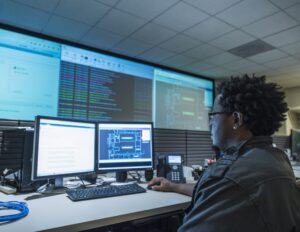In my last post I explained how lithium-ion (Li-ion) batteries are poised to bring dramatic change to UPS systems for small- to medium-size data centers, changes that will offer benefits including the ability to pack far more battery power into the same or smaller spaces, and extended lifetime. This time, I’ll examine how Li-ion technology stands to benefit UPS systems that protect large data centers and other critical facilities.
As explained in an earlier post, Li-ion batteries deliver the same amount of energy as the valve-regulated lead-acid batteries (VRLA) commonly used with UPS systems, but with dramatically reduced weight, footprint and cooling requirements. In some data center scenarios, as my last post explained, this means companies may no longer need separate battery rooms to house their VRLA batteries in order to keep them cooler than IT equipment needs to be.
Battery rooms are also common with respect to facility scale UPSs, including those for very large data centers, and will likely continue to be so long as they employ static UPSs associated with batteries, the most cost effective solution for short-term energy storage. But for years now, companies have been considering new architectures in order to address a number of issues:
- Reducing the footprint of the VRLA batteries
- Reduce maintenance requirements for large battery pools, including regular replacement
One approach to addressing these issues involves some variation of a rotary or “dynamic” UPSs that employ flywheels to fill short-term power gaps, replacing batteries. While these systems, also known as DRUPS (diesel rotary uninterruptible power supplies), do save on batteries space and maintenance, they provide far shorter backup times as compared to batteries – seconds vs. minutes. Also, they bring different challenges in the maintenance of mechanical components.
Li-ion batteries may change the equation. Static UPS systems based on upcoming generations of Li-ion will be even smaller than DRUPS systems, battery space requirements being a fraction of those needed for VRLA batteries. At the same time, the batteries will require a lower investment in cooling, because they generate less heat. The batteries won’t need regular replacing like VRLA batteries; indeed, the batteries will last as long as the UPS systems themselves. What’s more, the chemistry behind Li-ion batteries make them much more predictable to manage, and they come with a sophisticated battery management system, making for easier, more effective maintenance.
In other words, large static UPS systems with Li-ion batteries will bring all the benefits of static UPS technology while addressing the drawbacks of their traditional batteries, namely footprint, lifetime maintenance and cooling requirements. In short, static UPSs will be more competitive than ever for very large sites.
The benefits only stand to increase with time because we are in the early stages of Li-ion battery technology and I expect we’ll continue to see their performance improve (for instance, for high-power, short backup times) while costs come down, both at a rapid pace. Rotary UPSs, on the other hand, will likely improve only at the pace of other large mechanical machines, which is to say – slowly.
What’s more, I could picture Li-ion-based UPS systems playing additional roles for facilities, some day. As more and more smart grids emerge, powered sometimes by renewable energy sources, Li-ion technology can be used to store renewable energy for use during peak periods. This sort of technology will help customers more effectively deal with peak demand periods and reduce or avoid costly utility demand charges. That is a role UPSs based on VRLA batteries simply could never take on, given their limited cycling capabilities.
It’s not a stretch to say that Li-ion batteries may well transform facility UPSs. Today they’re largely seen as systems that are useful and necessary, but somewhat cumbersome and resource-hungry in terms of footprint, cost and maintenance, and dedicated to a single purpose. Tomorrow they may be seen as systems that are far more flexible and valuable, by becoming energy storage hubs that integrate with smart grid and renewable energy components of the facility.
I’d love to hear what you think of my vision for Li-ion battery technology as well as your thoughts about the topic. Feel free to let me know using the comments below.



Conversation
We know that Schneider Electric is often cautious, asking for advice, knowing perfectly well that the lithium-ion batteries have significant advantages over the other. Or are you waiting for sodium, which will be cheaper by 5-8 times? You can still wait for cold fusion. And time is not in favor of Schneider Electric!
Hi Aleksandr, thanks for your comment… No, we are not waiting and in fact have announced li-ion batteries on our UPS, see here https://www.schneider-electric.com/b2b/en/solutions/system/s4/data-center-and-network-systems-lithium-ion-battery/index.jsp
Good decision!
I haven’t tried it yet . But of course I it something that I could really use that hold the battery . with this Lithium- ion Batteries.i will give a tryi.